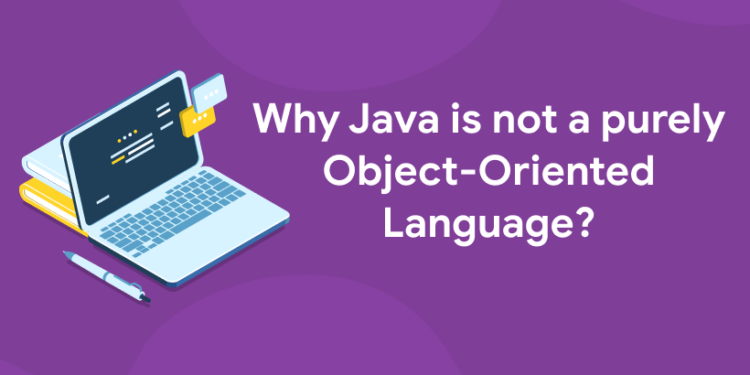Table of Contents
Java was designed by James Gosling at Sun Microsystems in 1990 and went on to replace C++ as the main programming pure object oriented language for Sun’s (and later Oracle’s) products. Java and Object-Oriented Programming (OOP) are two of the most important things in the modern world of software development. Java was created by Sun Microsystems, which was acquired by Oracle Corporation. A lot of programmers use Java, but it’s not always used in an object-oriented way (despite its name). The reason that Java isn’t purely object-oriented has to do with its design goals, the limitations of existing technology when it was created, and other factors that make it impossible to use it in this way. Java is considered to be the mother of all programming languages and has had the most influence on object-oriented programming (OOP). But many Java developers come from a non-Java background, so it’s often unclear whether Java actually is an object-oriented language or not. OOP focuses on data encapsulation and polymorphism, which are features that are not exclusive to Java as we will see below. So, whether you like it or not, Java might not be considered as Object-Oriented as some people think it to be.
Overloading
1: What is the default value of a boolean in Java?
Java doesn’t support method overloading as C++ does. This means that you can’t have two methods with the same name but different signatures in the same class. This can lead to some confusion, especially for beginners. For example, if we define one add() method taking an int and another add() method taking a double:
+ void add(int x) { }
+ void add(double x) { } + …you will find it difficult to determine which add() takes which type of parameter because there’s no way of knowing from just looking at the declaration. You would need to know what other classes exist in order to figure out what signature each add() has. Method Overriding: Java doesn’t allow subclassing of abstract classes or interfaces, meaning that you can’t override abstract methods by implementing them on a subclass or interface. A common use case for this is when you want to make an immutable version of a collection (i.e., so that once created, you can’t change its contents). In Java 8 this problem was partially solved with the introduction of default methods – but these still can’t be overridden on subclasses. Operator Overloading: In C++, you are able to overload any operator (e.g., ==). While there are extensions available for Java that let you do this too, it isn’t possible natively – and this makes things like sorting lists or finding min/max values much more cumbersome than they could be otherwise.
To know more about java programming in the Entri App
Explore Free Coding Courses !
Take your first step toward mastering in-demand skills, acing interviews, and securing top-tier jobs with Entri's free coding courses.
👉 Explore Free Courses NowAbstraction
The ability to create abstractions is one of the key features of object-oriented programming languages. However, Java only allows for abstraction at the class level, not at the instance level. This means that you can’t create an instance of an abstract class, and you can’t create an abstract method in a non-abstract class. You must declare any abstract methods as part of the concrete class. To remedy this problem, many developers use interfaces instead. However, using interfaces creates another problem: You can’t extend two interfaces. If a developer wants to implement both interface1 and interface2 then they must make their own abstract class that implements both interfaces. Then they must create a new concrete class that extends their own abstract class and implements the desired functionality. Another issue with interfaces is runtime type safety.
Enroll in our latest java programming course in the Entri app
At runtime, it’s impossible to tell if an object belongs to the type defined by the interface or its parent type because Java doesn’t support generic types or polymorphism over interface types. For example, if we have an Animal interface and Cow and Horse classes that implement it, it’s impossible to determine from runtime data whether a particular animal should be treated as a Cow or Horse until after runtime data has been processed. Objects are never aware of which interface they are implementing. A final issue with interfaces is that they cannot be nested – meaning they cannot contain other interfaces or other nested classes. A good way to remedy these problems is through code generation, where compiler code is generated based on annotation metadata (annotations being a core feature of java). In fact, there are tools available such as Javassist which will generate code based on annotated interfaces so you don’t need to write all the boilerplate code yourself
Get free placement assistance with the Entri app
Inheritance
One of the key features of object-oriented programming is inheritance, which allows programmers to create new classes that inherit the attributes and methods of existing classes. However, Java only allows single inheritance, meaning a class can only inherit from one superclass. This can lead to issues when trying to reuse code or create more flexible designs. For example, an application might want to define an interface with a collection of objects with a specific behavior (such as the ability to load data). Since interfaces cannot be instantiated in Java, this would require implementing two separate classes for each type of behavior. The lack of multiple inheritances also means that you cannot implement traits in Java like in other pure object oriented language such as Scala. Traits allow developers to share common functionality between unrelated types without having to define it twice. Traits also promote good software engineering practices by enabling functions or stateful variables on parent types to be reused on child types without requiring them at both levels.
Get the latest update on java programming in the Entri app
In contrast, Java doesn’t support the inheritance of state.
Finally, if a developer wants to use polymorphism—meaning they want their program to work with different types interchangeably—Java’s single inheritance makes it difficult because some of the basic mechanisms for achieving polymorphism are not supported. In addition, some cases where Java does support polymorphism have a special syntax that requires upcasting or downcasting depending on whether the desired type is above or below the current type in the hierarchy respectively. While these restrictions may seem minor, they often add complexity to the code and make it harder to understand what is happening. Also, since all instances of java.lang.The object must be subclasses of java.lang.Object and no subclass may specify any fields that don’t exist in its superclass (though some fields may be implemented differently), fields added after a class has been declared will never become accessible from outside the package or subtype unless a method is explicitly provided for doing so.
Explore Free Coding Courses !
Take your first step toward mastering in-demand skills, acing interviews, and securing top-tier jobs with Entri's free coding courses.
👉 Explore Free Courses NowAccess Specifiers
In Java, access specifiers are used to defining who can access a certain class, field, or method. There are four access specifiers: public, private, protected, and default. Public classes, fields, and methods can be accessed by anyone. Private classes, fields, and methods can only be accessed by the class they are defined in. Protected classes, fields, and methods can be accessed by the class they are defined in and any subclasses. Default classes, fields, and methods can only be accessed by classes in the same package. If two packages have a class with the same name, then one of them must be imported before the other one can be used.
The different access specifiers allow for different levels of accessibility depending on what level of privacy is desired. Also, without the need for an inheritance, there is no need to create subclassing that would violate encapsulation; since all changes are made at the class level. Objects cannot inherit from primitives and vice versa which eliminates problems such as the unintended conversion of types that may cause errors when compiling code. Types such as int cannot extend objects while an object cannot extend a primitive type like int because these types belong to different hierarchies which do not overlap; therefore eliminating potential problems caused by unintended conversion between primitive types and objects
Get the latest update on java programming in the Entri app
Packages
1. In Java, everything is contained in packages.
2. This means that you can have non-object data types, such as primitives, in your code.
3. While this might not seem like a big deal, it can actually make your code less understandable.
4. Another issue with packages is that they can lead to bloated code.
5. This is because you often have to import multiple packages just to use one class.
6. This can make your code very difficult to maintain and update.
7. Finally, packages can also make it difficult to reuse code since you have to be careful about which classes are in which package
This means that even if you come up with a class that works really well and solves your problem perfectly, if it’s not included in your required package then you still won’t be able to use it! So while the idea of creating an object-oriented language seems great on paper, Java doesn’t quite live up to the hype. The only reason it has become so popular is that its portability allows for easy integration with other languages or platforms without having to rewrite anything. So while it might not be perfect, Java does offer some significant benefits over other languages.
Exceptions
1. Exceptions in Java are not pure objects.
2. They are instances of the Throwable class, which is not a subclass of java.lang.Object.
3. TheThrowable class has two direct subclasses: Error and Exception.
4. Only objects of type Exception can be thrown by the Java Virtual Machine or caught by a catch clause.
5. Errors are not subject to the Catch or Specify Requirement.
6. The Throwable class has two direct subclasses: Error and Exception, but only objects of type Exception can be thrown by the Java Virtual Machine or caught by a catch clause.
7. TheError class has one direct subclass: VirtualMachineError
8. VirtualMachineError is not derived from Throwable, therefore it cannot be thrown or caught by a catch clause. 9. Because of this, Java is not pure object oriented language because it uses exceptions that do not belong to its own inheritance hierarchy.
10. It should be noted that there are other pure object oriented language such as C++ with exceptions that also fail the Catch or Specify requirement but they have more reasonable exception hierarchies than Java does so they are less problematic from an OOP perspective.
Static methods, variables, and fields
Though Java is commonly thought of as a pure object oriented language, it actually contains several features that are not object-oriented. For example, static methods, variables, and fields are not associated with any particular object, but rather with a class as a whole. This means that they can be accessed without having an instance of the class. Static members cannot use references to objects (i.e., this) because there is no object for them to reference in their context; however, they can contain nested classes. There also cannot be any instance variables in a static method or field because there are no instances to create them on – so all access must go through the class instead. In short, static fields do not belong to any one object and can only be accessed via the class itself. Static methods are similar to other regular methods, except that they cannot refer to the current object because there is no current object at run time. A final drawback of static members is that you cannot override them. The only way to replace a class member like a variable or function would be by declaring another member with the same name in another subclass which will have its own copy of all these attributes.
Enroll in our latest java programming course in the Entri app
Conclusion
Java is not a pure object-oriented language because it does not support multiple inheritances, it uses a primitive data type, it has a static keyword and more. These reasons make Java less flexible than some of the other options out there. However, Java is still a popular choice for many developers because it is relatively easy to learn and use. It also provides cross-platform compatibility that can be very helpful for developers. The lack of these features makes it easier to learn Java without being overwhelmed by complicated concepts. Overall, I would say that Java is an excellent option for beginners who are looking for a way to break into programming quickly. That said, it may not be the best option for advanced programmers who want something with more flexibility or power. For this reason, some people consider Java to be a weak object-oriented language. If you are interested to learn new coding skills, the Entri app will help you to acquire them very easily. Entri app is following a structural study plan so that the students can learn very easily. If you don’t have a coding background, it won’t be a problem. You can download the Entri app from the google play store and enroll in your favorite course.
Related Articles











